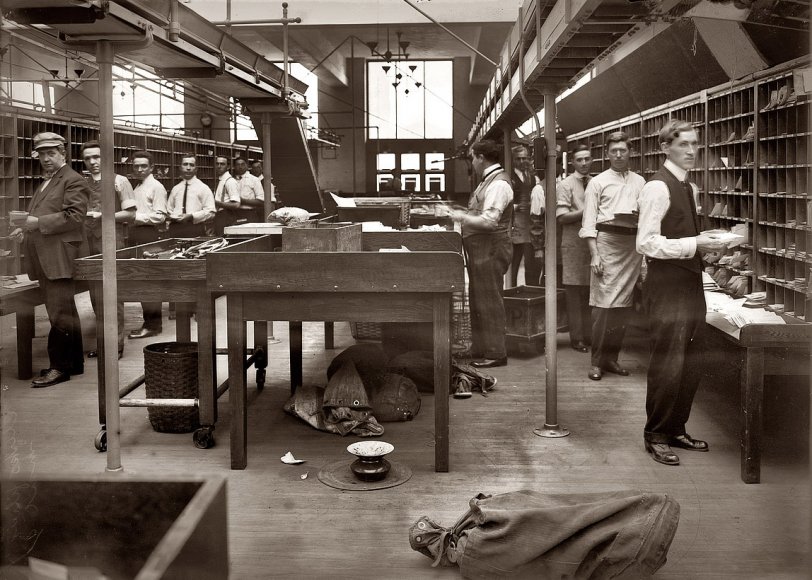


Framed or unframed, desk size to sofa size, printed by us in Arizona and Alabama since 2007. Explore now.
Shorpy is funded by you. Patreon contributors get an ad-free experience.
Learn more.

- What a headache!
- Baldwin 62303
- Baldwin VO-1000
- Cold
- No expense spared
- Tough Guys
- Lost in Toyland
- And without gloves
- If I were a blindfolded time traveler
- Smoke Consumer Also Cooks
- Oh that stove!
- Possibly still there?
- What?!?
- $100 Reward
- Freeze Frame
- Texas Flyer wanted
- Just a Year Too Soon
- WWII -- Replacing men with women at the railroad crossing.
- Yes, Icing
- You kids drive me nuts!
- NOT An Easy Job
- I wonder
- Just add window boxes
- Icing Platform?
- Indiana Harbor Belt abides
- Freezing haze
- Corrections (for those who care)
- C&NW at Nelson
- Fallen Flags
- A dangerous job made worse
Print Emporium
The Office: 1913

"Boxing mail in the New York post office." View full size. Circa 1913. 5x7 glass negative, George Grantham Bain Collection. Note the spittoon.
Railway mail service
Was where my uncle worked in the 40's, 50's, and 60's. He loved his work of sorting mail as the train ran between Little Rock and Fort Worth. He always carried a loaded 38 cal revolver as part of his job. There was never an attempted robbery on his run. He worked 3 days and off 4. When he was about 55 his train derailed and he was bounced around the entire car, but amazingly he and his sorting partner had only bruises and scratches. Another memory delivered by Shorpy. Thanks!
Target Practice
Lots of overspray around the ol' spittoon.
Postal jargon
I'm not up on my history of postal jargon, but in my day (1968-2007) "boxing" mail meant placing mail in customers' post office boxes. What's going on here is the processing and initial sorting of outgoing mail. The overhead conveyor and the chute would carry mail collected from drop boxes to the center area where it's culled and faced. Culling is separating parcels and large envelopes from letters, which are then faced, or arranged all in the same direction, prior to running them through the stamp cancelling/postmarking machine. That's what the guy in the center is doing.
All the others are performing what, again in my day, was called primary case distribution, sorting the cancelled mail to major separations. As there are only 56 (49 in my day) separations, not enough to accommodate all the possible destinations, a finer secondary sort of each of those initial separations would be necessary - in those days according to railway routes. Further sorting could occur enroute on the train itself in special mail cars. We called sorting mail into distribution cases "throwing" mail.
I was doing exactly this, in this same way, on equipment that looked just like this (except it was metal rather than wood), in 1968 in a small post office. By then, the larger installations had begun to be mechanized. Facing was accomplished by machines that detected the phosphorescent tags applied to stamps starting in the 1950s, sorting was done using manually-operated letter-sorting machines, then eventually optical character readers until the present day when the letter you mail isn't touched by any human hands until your carrier puts it in your mailbox.
























On Shorpy:
Today’s Top 5